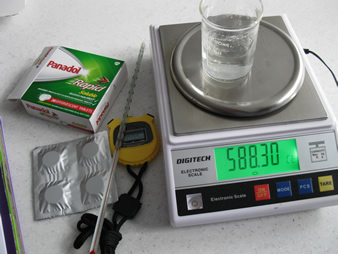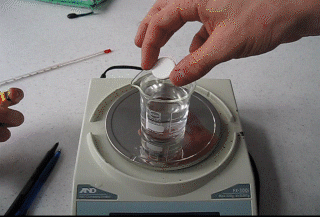When panadol tablets dissolve a chemical reaction takes place that releases carbon dioxide.
Equipment needed for this investigation is shown on the right.
Access to hot water is also required via a hot water urn.
- ice
- effervescent Panadol tablets
- thermometer
- 200mL beaker
- stop watch
- electronic balance
In this investigation students are asked to find the time taken for a Panadol tablet to dissolve in water at a temperature of 100oC. The water supplied is not at 100oC hence students collect data and produce a model for the dissolving of Panadol in water of a given temperature. This model is then used to answer the question.

The rate of the reaction can be measured by measuring the rate at which mass is lost.
Dissolve a number of Panadol tablets at a range of temperatures and record the time it takes for the tablet to be completely dissolved, when the fizzing stops. Record your results in the table below.
It is up to the student to determine the range of temperatures to be tested.
The electronic scales are not necessary for this part of the investigation but necessary for an extension to measure the imapct of surface area to rate of reaction.

| Time (Sec) | Temperature (oC) |
Things to consider when drawing a graph.
- Dependent variable = y-axis
- Independent variable = x-axis
- Heading
- Evenly spaced units on each axis
- Units labelled on each axis.
- Accurately plotted data points.
- Line of best fit ignoring outliers.

1) Outline and explain a testable hypothesis using scientific reasoning.
The rate at which the reaction proceeds will increase at higher temperatures hence the tablet will dissolve quicker the hotter the temperature. Collisions between reactants at higher temperatures have, on average, higher kinetic energy and therefore an increased likelihood that hey will react.
2) State the dependent and independent variables. Describe how the variables were measured or manipulated.
Dependent variable = time taken to dissolve, measured in seconds
Independent variable = temperature of the water measured in oC
The independent variable was changed using ice and hot water to achieve 5 different temperatures of water in which 5 identical tablets of Panadol were dissolved, one in each temperature.
3) Using your graph predict the time taken for a tablet to be completely dissolved at 100oC.
The student uses the line of best fit to extrapolate to the 100oC temperature range and read off the graph the time taken.
4) How accurate is the predictions in question 2 above compare to the prediction of time taken to dissolve at 30oC?
Extrapolation is not as accurate as reading points between two measured values. The 100oC prediction is out of the range of the data collected and hence inaccurate where as the 30oC prediction is within the measured data points and hence more accurate.
5) What are the controlled variables?
- Volume of water
- Type of tablet (must be identical tablets, shape and mass)
-
the same electronic scale must be used
6) Suggest how the controlled variables will be manipulated and why it is necessary to control them.
- The volume of water remains constant throughout each trial. Differences in the amount of water may influence the rate at which the tablets dissolve, with the tablets immersed in a greater volume of water dissolving quicker. This will make it impossible to attribute the rates of reaction directly to the temperature.
- The type of tablet is critical since different shapes, sizes and masses will obviously contribute to different rates of reaction and again it would impossible to attribute the rate of reaction directly to temperature.
7) Design a safe, logical sequence of steps that forms the method for this investigation.
A logical and safe set of steps, dot points, that anyone repeating the investigation can follow to mimic the experimental protocol.
A comprehensive list of equipment should be given including the volume of beakers, range of thermometers and scales etc.